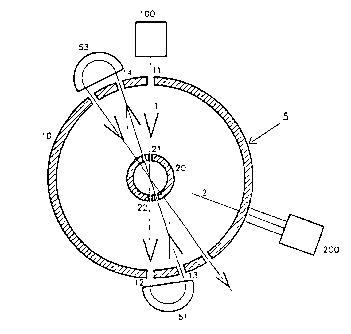Une partie des informations de ce site Web a été fournie par des sources externes. Le gouvernement du Canada n'assume aucune responsabilité concernant la précision, l'actualité ou la fiabilité des informations fournies par les sources externes. Les utilisateurs qui désirent employer cette information devraient consulter directement la source des informations. Le contenu fourni par les sources externes n'est pas assujetti aux exigences sur les langues officielles, la protection des renseignements personnels et l'accessibilité.
L'apparition de différences dans le texte et l'image des Revendications et de l'Abrégé dépend du moment auquel le document est publié. Les textes des Revendications et de l'Abrégé sont affichés :
| (12) Brevet: | (11) CA 2110067 |
|---|---|
| (54) Titre français: | ACCELERATEUR D'ELECTRONS A CAVITE COAXIALE |
| (54) Titre anglais: | ELECTRON ACCELERATOR HAVING A COAXIAL CAVITY |
| Statut: | Périmé et au-delà du délai pour l’annulation |
| (51) Classification internationale des brevets (CIB): |
|
|---|---|
| (72) Inventeurs : |
|
| (73) Titulaires : |
|
| (71) Demandeurs : |
|
| (74) Agent: | GOWLING WLG (CANADA) LLP |
| (74) Co-agent: | |
| (45) Délivré: | 2001-12-11 |
| (86) Date de dépôt PCT: | 1992-05-27 |
| (87) Mise à la disponibilité du public: | 1992-12-10 |
| Requête d'examen: | 1999-03-22 |
| Licence disponible: | S.O. |
| Cédé au domaine public: | S.O. |
| (25) Langue des documents déposés: | Anglais |
| Traité de coopération en matière de brevets (PCT): | Oui |
|---|---|
| (86) Numéro de la demande PCT: | PCT/BE1992/000023 |
| (87) Numéro de publication internationale PCT: | WO 1992022190 |
| (85) Entrée nationale: | 1993-11-25 |
| (30) Données de priorité de la demande: | ||||||
|---|---|---|---|---|---|---|
|
An electron accelerator having a first source emitting an electron
beam to be accelerated, and a coaxial cavity defined by an outer cylindrical
conductor and an inner cylindrical conductor lying on a single axis and joined
by
two flanges, wherein the electron beam is injected in the mid-plane which is
perpendicular to the axis along a first diameter of the outer conductor. The
accelerator is characterized in that it comprises a second source emitting an
electron beam which decelerates as it passes through the coaxial cavity,
whereby
the electromagnetic field required to accelerate the electron beam from the
first
source is produced.
Note : Les revendications sont présentées dans la langue officielle dans laquelle elles ont été soumises.
Note : Les descriptions sont présentées dans la langue officielle dans laquelle elles ont été soumises.

2024-08-01 : Dans le cadre de la transition vers les Brevets de nouvelle génération (BNG), la base de données sur les brevets canadiens (BDBC) contient désormais un Historique d'événement plus détaillé, qui reproduit le Journal des événements de notre nouvelle solution interne.
Veuillez noter que les événements débutant par « Inactive : » se réfèrent à des événements qui ne sont plus utilisés dans notre nouvelle solution interne.
Pour une meilleure compréhension de l'état de la demande ou brevet qui figure sur cette page, la rubrique Mise en garde , et les descriptions de Brevet , Historique d'événement , Taxes périodiques et Historique des paiements devraient être consultées.
| Description | Date |
|---|---|
| Inactive : CIB de MCD | 2006-03-11 |
| Le délai pour l'annulation est expiré | 2003-05-27 |
| Lettre envoyée | 2002-05-27 |
| Accordé par délivrance | 2001-12-11 |
| Inactive : Page couverture publiée | 2001-12-10 |
| Inactive : Taxe finale reçue | 2001-09-05 |
| Préoctroi | 2001-09-05 |
| Un avis d'acceptation est envoyé | 2001-05-23 |
| Un avis d'acceptation est envoyé | 2001-05-23 |
| Lettre envoyée | 2001-05-23 |
| Inactive : Approuvée aux fins d'acceptation (AFA) | 2001-05-11 |
| Inactive : Dem. traitée sur TS dès date d'ent. journal | 1999-04-14 |
| Inactive : Acc. réc. RE - Pas de dem. doc. d'antériorité | 1999-04-14 |
| Inactive : Renseign. sur l'état - Complets dès date d'ent. journ. | 1999-04-14 |
| Toutes les exigences pour l'examen - jugée conforme | 1999-03-22 |
| Exigences pour une requête d'examen - jugée conforme | 1999-03-22 |
| Modification reçue - modification volontaire | 1999-03-22 |
| Demande publiée (accessible au public) | 1992-12-10 |
Il n'y a pas d'historique d'abandonnement
Le dernier paiement a été reçu le
Avis : Si le paiement en totalité n'a pas été reçu au plus tard à la date indiquée, une taxe supplémentaire peut être imposée, soit une des taxes suivantes :
Veuillez vous référer à la page web des taxes sur les brevets de l'OPIC pour voir tous les montants actuels des taxes.
| Type de taxes | Anniversaire | Échéance | Date payée |
|---|---|---|---|
| TM (demande, 5e anniv.) - générale | 05 | 1997-05-27 | 1997-05-26 |
| TM (demande, 6e anniv.) - générale | 06 | 1998-05-27 | 1998-05-07 |
| Requête d'examen - générale | 1999-03-22 | ||
| TM (demande, 7e anniv.) - générale | 07 | 1999-05-27 | 1999-05-04 |
| TM (demande, 8e anniv.) - générale | 08 | 2000-05-29 | 2000-04-28 |
| TM (demande, 9e anniv.) - générale | 09 | 2001-05-28 | 2001-03-30 |
| Taxe finale - générale | 2001-09-05 | ||
| TM (demande, 2e anniv.) - générale | 02 | 1994-05-27 |
Les titulaires actuels et antérieures au dossier sont affichés en ordre alphabétique.
| Titulaires actuels au dossier |
|---|
| ION BEAM APPLICATIONS SOCIETE ANONYME |
| Titulaires antérieures au dossier |
|---|
| YVES JONGEN |